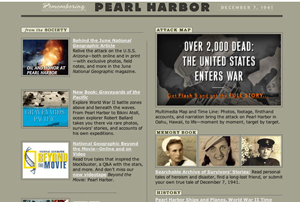talking history | syllabi | students | teachers | puzzle | about us
National Geographic: Remembering Pearl Harbor
http://plasma.nationalgeographic.com/pearlharbor/
Created by Nationalgeographic.com, Washington, D.C., and Second Story Interactive Studios, Portland, OR. Maintained by Nationalgeographic.com.
Reviewed March 1–7, 2006.
National Geographic: Remembering Pearl Harbor contains virtual war maps, first-hand accounts, photographs, and timelines. The Web site links to model assignments fashioned for different levels of K–12 learners. Constructed by Nationalgeographic.com in 2001, its displays offer subscriptions to National Geographic Magazine; books, games, and other products from National Geographic’s virtual museum store; and features related to the 2001 film Pearl Harbor. The site seems designed for the general public and school assignments.

The site’s central feature is a multimedia “attack map.” Presented in an engaging and well-designed interactive format, the map of Oahu provides a framework for recounting the attack through photos, footage, and narration. By choosing to access different amounts of information, users may move through the feature at their own speed.
A section called “History,” linked from the opening page, contains a drop-down menu with four categories. (1) A table presents specifications for U.S. and Japanese ships and planes and gives information about their roles—what each one targeted or how it was damaged. (2) A timetable of December 7, 1941, succinctly summarizes the major diplomatic and military events. (3) Another timetable, extending from August 1939 to September 1945, provides an overview of the major events and battles of World War II. Although a textual prologue indicates that the war in Asia began in 1931, not 1939, the timeline reinforces a Eurocentric view by omitting most of the context of U.S.-Japanese relations during the 1930s. (4) A final category links to additional Web-based resources, including lesson plans, and provides a short list of suggested readings. All information in this section appears in easy-to-read and print form, although there seems to have been no updating since 2001.
The “Memory Book” section, also linked from the main page, provides dozens of well-chosen photos and a forum to record memories. An initial screen warns that the open forum will not be reviewed or edited, and users will need to approach with caution. The best responses provide descriptive, often moving, stories that convey loss, heroism, disability, fright, horror. Those accounts contribute immediacy and human scale. More common, however, are the testimonials to fathers or friends and the generalized expressions of patriotism. These memorials speak powerfully to the attack’s impact on American life, but they become repetitious and may not hold readers' attention. Then there are fake entries with invented scenarios about guns and gore that seem contributed by a video-game generation with little understanding of what might be appropriate. The Memory Book may interest readers willing to search through hundreds of entries, which come up in groups of five at a time. For this user, however, the feature was not particularly successful.
Teachers may turn to this Web site for lesson plans, which are linked as a “resource” to http://www.nationalgeographic.com/xpeditions/lessons/13/g912/ready.html. The lesson plans, part of National Geographic’s Xpeditions Web site and the home to the National Geography Standards, are not technically part of the Pearl Harbor site, but they do use the specifics of the attack to suggest lessons in geography, history, international relations, and strategy. Well crafted and age-appropriate, the assignments may stimulate students to research beyond the rather limited material on the Pearl Harbor site and delve into broader, more interpretive questions.
Emily S. Rosenberg
University of California
Irvine, California
